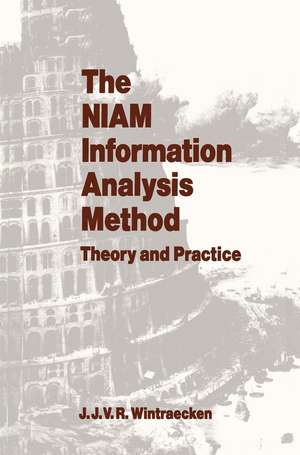The NIAM Information Analysis Method: Theory and Practice
Autor J.J.V.R. Wintraeckenen Limba Engleză Paperback – 4 oct 2011
Preț: 341.81 lei
Preț vechi: 427.26 lei
-20% Nou
Puncte Express: 513
Preț estimativ în valută:
65.41€ • 68.04$ • 54.00£
65.41€ • 68.04$ • 54.00£
Carte tipărită la comandă
Livrare economică 14-28 aprilie
Preluare comenzi: 021 569.72.76
Specificații
ISBN-13: 9789401066877
ISBN-10: 9401066876
Pagini: 488
Ilustrații: 484 p.
Dimensiuni: 155 x 235 x 26 mm
Greutate: 0.68 kg
Ediția:Softcover reprint of the original 1st ed. 1990
Editura: SPRINGER NETHERLANDS
Colecția Springer
Locul publicării:Dordrecht, Netherlands
ISBN-10: 9401066876
Pagini: 488
Ilustrații: 484 p.
Dimensiuni: 155 x 235 x 26 mm
Greutate: 0.68 kg
Ediția:Softcover reprint of the original 1st ed. 1990
Editura: SPRINGER NETHERLANDS
Colecția Springer
Locul publicării:Dordrecht, Netherlands
Public țintă
ResearchCuprins
1 The NIAM Method of Information Analysis.- 1.1 Knowledge, information, and communication.- 1.2 The information system.- 1.3 The development of an information system.- 1.4 The main principles of the NIAM method of information analysis.- 1.5 Summary.- 2 An Information System Model.- 2.1 The message exchange with the environment.- 2.2 The information base.- 2.3 The grammar.- 2.4 The information processor.- 2.5 Summary.- 3 From Object System Analysis to Information Analysis.- 3.1 The organization of the library.- 3.2 The activity diagram.- 3.3 The information system within the object system.- 3.4 From object system analysis to information analysis.- 3.5 The information flow diagram.- 4 The Structure of Information.- 4.1 A more detailed definition of information.- 4.2 Elementary propositions.- 4.3 Lexical and non-lexical objects.- 4.4 Facts, ideas, and bridges.- 4.5 Non-lexical and lexical object types.- 4.6 Fact types, idea types, and bridge types.- 4.7 Facts and rules.- 4.8 Static constraints and transition constraints.- 5 Describing Information.- 5.1 The natural language principle.- 5.2 A general structural formula for elementary sentences.- 5.3 Elementary deep structure sentences.- 5.4 Elementary sentence types.- 5.5 Sentences of the same type with different predicates.- 5.6 Population tables.- 5.7 A general structural formula for elementary sentence types.- 5.8 A graphical representation for elementary deep structure sentences.- 5.9 A graphical representation for elementary sentence types.- 5.10 Describing the grammar of an information system.- 5.11 The information structure diagram.- 5.12 References to roles and role populations.- 5.13 References to subsets and combinations of role populations.- 5.14 Graphical and non-graphical constraints.- 5.15 The operation of an information system.- 6 The NIAM Method of Information Analysis in Practice — 1.- 6.1 The catalog card.- 6.2 The first addition to the catalog card.- 6.3 Summary.- 7. Graphical Constraints Involving one Fact Type.- 7.1 Uniqueness constraints.- 7.2 Some examples of uniqueness constraints.- 7.3 Uniqueness constraints involving bridge types.- 7.4 Totality constraints.- 7.5 Totality constraints involving bridge types.- 7.6 Referenceability.- 7.7 An abridged notation for bridge types.- 8 The NIAM Method of Information Analysis in Practice — 2.- 9 Graphical Constraints Involving Multiple Fact Types.- 9.1 Equality constraints.- 9.2 Subset constraints.- 9.3 Exclusion constraints.- 9.4 Implied equality and subset constraints.- 10 Graphical Constraints Involving Combinations of Roles.- 10.1 Subset constraints involving combinations of roles.- 10.2 Exclusion constraints involving combinations of roles.- 10.3 Uniqueness constraints involving roles of different fact types.- 10.4 Totality constraints involving combinations of roles.- 10.5 Referenceability.- 10.6 Idea types involving one object type.- 11 The NIAM Method of Information Analysis in Practice — 3.- 11.1 The classification system.- 11.2 Primary and secondary categories.- 11.3 Translations.- 11.4 The loan card.- 11.5 Historical information.- 11.6 Summary.- 12 Fact Types Consisting of More Than Two Roles.- 12.1 Unique combinations of roles in ternary sentence types.- 12.2 Implied uniqueness constraints.- 12.3 Unique roles in ternary sentence types.- 12.4 The n-1 rule.- 12.5 Replacing non-binary fact types by binary fact types.- 13 The NIAM Method of Information Analysis in Practice — 4.- 13.1 The reservation card.- 13.2 The day number sequence 305 13.3 Summary.- 14 Fact Types Consisting of one Role.- 14.1 Unarysentence types and unary fact types.- 14.2 Subtypes.- 14.3 Constraints with respect to subtypes.- 14.4 Object type families.- 14.5 Introducing subtypes into an information structure diagram.- 15 The NIAM Method of Information Analysis in Practice — 5.- 16 Non-Graphical Constraints.- 16.1 Value constraints.- 16.2 Cardinality constraints.- 16.3 Subtype defining constraints.- 16.4 Other non-graphical constraints.- 16.5 Non-graphical descriptions of graphical constraints.- 16.6 Derivable fact types.- 16.7 Transition constraints.- 16.8 Summary.- 17 The NIAM Method of Information Analysis in Practice — 6.- Appendix 1: The data model.- Appendix 2: Definitions, symbols, principles, rules and analysis steps.- References and Bibliography.











